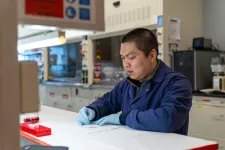(Press-News.org)
BEER-SHEVA, Israel, April 17, 2023 – Scientific research must meet clear ethical guidelines to prevent harm to participants. However, research can also indirectly harm individuals and social groups, for example by shaping social perceptions and inspiring policy. Researchers receive little to no training on how to consider and minimize such harm.
To that end, Ben-Gurion University of the Negev's Dr. Niv Reggev and his international colleagues have published ten simple rules for socially responsible science. The article was just published in PLOS Computational Biology.
Recently, there have been more and more calls for scientists to be held accountable for the social impact of their studies in addition to their findings. Therefore, Dr. Reggev of the Department of Psychology and School of Brain Sciences and Cognition at Ben-Gurion University, along with Dr. Alon Zivony of Birkbeck College at the University of London and the University of Sheffield, Dr. Rasha Kardosh of NYU, and Dr. Liadh Timmins of Swansea University decided it was time to brainstorm some actionable rules.
“Scientific studies impact societal norms through how they are designed, conducted, and reported. Although acknowledged for many years—perhaps the best-known example of which being a fraudulent study that triggered vaccine hesitancy—scientists interested in ensuring their outputs do not unwittingly cause societal harm often lack the tools and training to do so. In response to this lacuna, we formulated a set of ten simple rules that can help interested scientists in thinking about socially responsible science. We emphasize these rules are not meant to be prescriptive; rather, they are intended to assist in guiding and thinking about these issues,” the researchers explain.
The ten rules govern the entire lifecycle of a study, from planning to publication.
They are:
Get diverse perspectives early on
Understand the limits of your design with regard to your claims
Incorporate underlying social theory and historical events
Be transparent about your hypothesis and analyses
Report your results and limitations accurately and transparently
Choose your terminology carefully
Seek a rigorous review and editorial process
Play an active role in ensuring correct interpretations of your results
Address criticism from peers and the general public with respect
When all else fails, consider submitting a correction or a self-retraction
Get diverse perspectives early on – If you are writing about a marginalized group, consider reaching out to members of that group for "insider" information as they hold perspectives crucial to your research.
Understand the limits of your design with regard to your claims – Thinking about limitations in advance is always better than a limitations paragraph at the end of a flawed study.
Incorporate underlying social theory and historical events – Social context matters. Not including it can lead readers to the wrong conclusions about the phenomenon being studied.
Be transparent about your hypothesis and analyses – Pre-registering the study protocols and analysis limits the risk of drawing incorrect conclusions and inspires confidence in one's conclusions.
Report your results and limitations accurately and transparently – Try not to oversimplify your results. Sometimes science is complicated. Uploading data and analysis to an online repository allows our peers to double check the data and reproduce the experiment.
Choose your terminology carefully – If you are coining a new term or discussing a particular group, make sure you aren't reinforcing stereotypes. One way to avoid this is to run it by some members of the group you are researching.
Seek a rigorous review and editorial process – Such a process is the last line of defense in keeping the scientific literature free from errors and flaws that the authors overlooked. A rigorous review process also increases the confidence of the scientific community and the general public in the results.
Play an active role in ensuring correct interpretations of your results – Work with University or journal press offices to ensure that the press release sent out is accurate and does not sensationalize the findings.
Address criticism from peers and the general public with respect – Hot button topics generate knee jerk responses as well as thoughtful criticism. Take time to review criticism and respond thoughtfully and with respect to all.
When all else fails, consider submitting a correction or a self-retraction – If subsequent criticism reveals a flaw, then a correction or a self-retraction might be in order. While a self-retraction is viewed as a ‘heroic’ admission of one’s mistakes, journal-retractions are perceived as a ‘guilty’ verdict.
“When no training exists, scientific outputs can often (unknowingly) harm society. From reinforcing social stereotypes to creating a biased AI-based tool, well-meaning scientists often generate scientific studies that unwittingly lead to detrimental societal impacts. Here we proposed a theoretical framework and a set of ten actionable rules to help scientists prevent such negative societal consequences,” Dr. Reggev concludes on behalf of the team.
END
In parts of California’s iconic mountainous coasts, breathtaking beauty is punctuated by brusque signs warning spectators to stay back from unstable cliffs. The dangers of coastal erosion are an all-too-familiar reality for the modern residents of these communities. Now, with a new tool, researchers are bringing historical perspective to the hotly debated topic of how to manage these disappearing coastlines.
Using a model that incorporates measurements of the amount of time coastal cliffs and their remnant deposits were exposed at the Earth’s surface, Stanford researchers found that the rate of cliff erosion in the past 100 years is ...
People living with long Covid who suffer from loss of smell show different patterns of activity in certain regions of the brain, a new study led by UCL researchers has found.
The research used MRI scanning to compare the brain activity of people with long Covid who lost their sense of smell, those whose smell had returned to normal after Covid infection, and people who had never tested positive for Covid-19.
Published in eClinicalMedicine, the observational study found that the people with long Covid smell loss had reduced brain activity and impaired communication between two parts of the brain which process ...
SAN ANTONIO — April 17, 2023 —Southwest Research Institute staff members have converged upon Detroit this week to share their respective expertise with the mobility industry at the 2023 SAE International WCX™ World Congress Experience.
WCX is the “largest technical mobility event developed by the industry, for the industry,” according to SAE. The conference, which takes place April 17-20, invites mechanical, electrical and software engineers working in mobility from around the world to share knowledge and research to overcome the latest challenges facing the industry.
As leaders in mobility and automotive research, ...
Through careful crossbreeding and selection, University of Maryland researchers have developed what may just be the perfect apples for American growers trying to adapt to a changing world. The two new apples, a yellow and a red one are heat-tolerant, blight-tolerant, low-maintenance, easy to harvest and not least, delicious-tasting. Both have been approved for patents and are awaiting the final grant from the U.S. Patent Office.
They address a growing suite of problems the apple industry has been grappling with. The fruit has always been labor-intensive to bring to market, with trees that need to be trained, pruned, ...
Barcelona, Spain – 17 April 2023: Thirty day electrocardiogram (ECG) monitoring in patients with hypertrophic cardiomyopathy (HCM) detects more arrhythmias than the standard 24 to 48 hours, according to late breaking science presented at EHRA 2023, a scientific congress of the European Society of Cardiology (ESC).1
Up to 20% of patients with HCM develop atrial fibrillation during the course of the disease2,3 and are at particularly high risk of stroke. Therefore, guidelines do not recommend the CHA2DS2-VASc score4 to calculate stroke risk but advise starting anticoagulant treatment in all patients with HCM ...
Edward Chouchani receives a Vilcek Prize for Creative Promise in Biomedical Science for his work to decipher the molecular mechanisms that drive metabolic disease, with the aim of developing therapeutic interventions.
The Vilcek Prize for Creative Promise is a $50,000 recognition awarded annually by the Vilcek Foundation as part of its prizes program. Awarded annually since 2006, the Vilcek Foundation prizes recognize and celebrate immigrant contributions to scientific research and discovery, and to artistic and cultural advancement in the United States. The Vilcek Foundation prizes support the Vilcek Foundation’s mission to raise public awareness of the value ...
A parabolic dish on the EPFL campus is easily overlooked, resembling a satellite dish or other telecommunications infrastructure. But this dish is special, because it works like an artificial tree. After concentrating solar radiation nearly 1,000 times, a reactor above the dish uses that sunlight to convert water into valuable and renewable hydrogen, oxygen, and heat.
“This is the first system-level demonstration of solar hydrogen generation. Unlike typical lab-scale demonstrations, it includes all auxiliary devices and components, so it gives us a better idea of the energy efficiency you can expect ...
Using a new detection method, UC Riverside scientists found a massive amount of methane, a super-potent greenhouse gas, coming from wildfires — a source not currently being accounted for by state air quality managers.
Methane warms the planet 86 times more powerfully than carbon dioxide over the course of 20 years, and it will be difficult for the state to reach its required cleaner air and climate goals without accounting for this source, the researchers said.
Wildfires emitting methane ...
McMaster University researchers have developed a rapid and inexpensive test for Salmonella contamination in chicken and other food – one that’s easier to use than a home COVID test.
The test, described in a new paper in the journal Angewandte Chemie, could improve food safety, reduce the cost of processing fresh poultry and other foods, and help to limit broad recalls to batches that have specifically been identified as contaminated.
The researchers have shown that the test provides accurate results in an hour or less without the need for accessories or a power source, compared ...
PULLMAN, Wash. – Discovery of a gene in multiple mammalian species could pave the way for a highly effective, reversible and non-hormonal male contraceptive for humans and animals.
Washington State University researchers identified expression of the gene, Arrdc5, in the testicular tissue of mice, pigs, cattle and humans. When they knocked out the gene in mice, it created infertility only in the males, impacting their sperm count, movement and shape. The researchers detailed their findings in the journal Nature Communications.
“The study identifies this gene for the first time as being expressed ...





